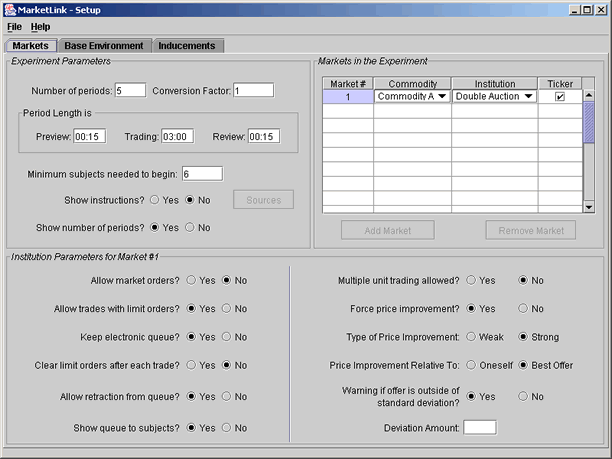|
|
|
The Markets tab, which is shown in figure 1, is used to select
(1) characteristics of the experiment session, (2) the number of
commodities that are traded and the institution(s) they trade in,
and (3) details of the market institution for each market. The
screen display on the Markets tab has a separate area for each of
these functions. Each of these three areas is described below.
|
|
Some of the parameters in an experiment apply broadly to the experiment session, rather than to specific subjects or to specific markets. The Experiment Parameters area, at the upper left on the 'Markets' tab of
the MarketLink Configuration Editor, is used to define elements that
are common to all subjects in the experiment, and common to all markets
that are open. These parameters are listed below.
Experiment Parameters
- the number of trading periods in the experiment session;
- the conversion rate, which specifies the amount of
currency that a subject receives per unit of
experiment payoff earned;
- the length of each trading period (each of which is broken
into three phases);
- during the preview phase, the subject can examine induced
costs or values, or induced dividend schedules, and other
aspects of the market that are relevent to the subject's
decision problem;
- the trading phase is the period of time during a trading
period when exchanges occur;
- the review phase provides an opportunity to subjects to
examine the trades that they have completed and the
profits earned as a result of these trades;
- the minimum number of subjects required to start
the session;
- whether instructions are shown to subjects when they
start the client application; and
- whether the subject is informed of the number of
trading periods in the experiment session when the
session begins.
|
|
This area is used to define the Markets that are open, and the market
institution for each open market. Currently, MarketLink supports two
market institutions - the double auction and the posted offer auction -
but it only supports one market, so the only decision to be made when
editing this area is the institution. Eventually though, when multiple
markets are included in MarketLink, more choices will be possible in
this area.
|
|
This area is used to define many of the specific rules of the market
institution. For the double auction, there are a number of possible
variants of the market rules, such as whether only limit orders are
permitted, or both limit and market orders are permitted, whether a
buyer's bid that is displaced by another buyer's bid is then placed
in a queue for later execution, and so forth.
For the double auction, the institution parameters in MarketLink
are listed below, as they apply to buyers. The effects on sellers
are analogous.
|
- whether market orders to buy, which are orders that execute at
the current best (lowest) ask, are allowed;
- whether limit orders, which specify a maximum price a buyer is
willing to pay, are allowed;
- whether an electronic queue of bids is maintained;
- whether limit orders are removed after each trade;
- whether bids can be removed from the queue;
- whether the queues are revealed to the traders;
- whether trades in blocks of more than one unit are permitted;
- whether new bids must improve upon previous bids;
- whether the type of price improvement is weak (a new bid must
be at least as high as the current best bid) or strong (a new
bid must be higher than the current best bid);
- whether the bid improvement rule is relative to ones own bid
or to the market best bid;
- whether buyers receive a warning message if their bid is more
than 'n' standard deviations above the mean trade price
(where the mean is taken over at most the past 20 trades).
|

Figure 1: Markets tab from the MarketLink Configuration editor.
|
| |